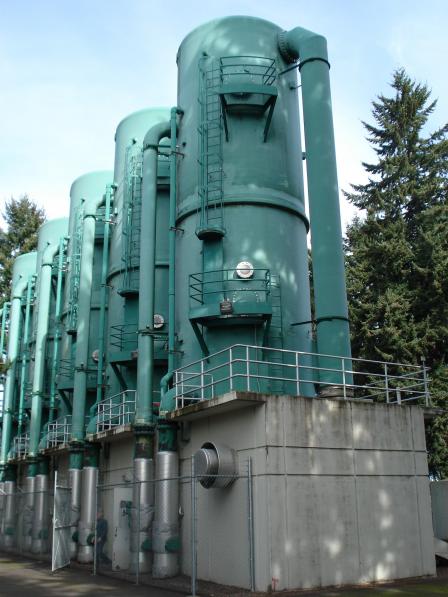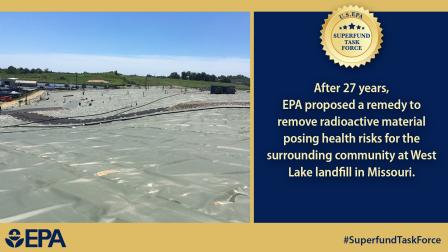Superfund Task Force News
2019
2018
- EPA Selects Six Superfund Adaptive Management Task Force Pilots
- EPA Issues Technical Guides to Streamline Site Cleanup
- EPA Updates Administrator’s Emphasis List
- Memorandum Issued on Task Force Recommendation 20’s Findings and Recommendations on Third Party Oversight of Aspects of PRP-Lead Cleanups
- Request for Regional Superfund Task Force Adaptive Management Pilot Nominations
- Task Force Streamlines Access to In-House Technical Support
- Acting Administrator Wheeler Signs the Record of Decision Amendment for the West Lake Landfill Superfund Site in Missouri
- Principles for Reinforcing Federal Facility Agreement Informal and Formal Dispute Timelines
- Acting Administrator Wheeler Updates List of Superfund Sites Targeted for Immediate, Intense Action
- EPA's Site Remediation Enforcement Director Issues Memorandum to Regions to Support Long-Term Stewardship
- Acting Administrator Andrew Wheeler Commemorates the One-Year Anniversary of the Superfund Task Force at the New Bedford Harbor Superfund Site
- EPA Region 5 Administrator Announces Cleanup Achievements at the Kalamazoo River Superfund Site in Michigan
- Superfund Director Issues Memorandum to the Regions to Broaden the Use of Adaptive Management at Sites
- Memorandum to the Regions regarding Recommendation 12 of the Superfund Task Force Report
- Treatment Begins at CTS of Asheville Superfund Site
- EPA Announces Cleanup Proposal for American Cyanamid Superfund Site in Bridgewater Township, NJ
- EPA Region 1 Administrator Alexandra Dunn and Connecticut Environmental Commissioner Robert Klee celebrate that the cleanup of the Raymark Industries Superfund Site in Stratford, Conn. will begin soon
- EPA Proposes Interim Plan to Address Contamination for Berry’s Creek Portion of Ventron/Velsicol Superfund Site in NJ
- EPA issues guidance on disbursement of special account funds to entities performing cleanup work at Superfund sites
- EPA Releases Two Technical Documents to Further Use of In Situ Remediation Technologies
- Former Administrator Pruitt Signs $107.6M Action Memorandum to Clean Up the Mississippi Phosphates Corporation Superfund Site
- Memorandum Issued to Spur Investment and Address Liability Concerns for Third Parties at Superfund Sites
- Former Administrator Pruitt Updates List of Superfund Sites Targeted for Immediate, Intense Action
- EPA Reaches Agreement on San Jacinto River Cleanup
- Superfund Task Force Issues Second Quarterly Report
- EPA Deletes Part of Pacific Coast Pipe Line Site from National Priorities List
- EPA Deleted Massachusetts Site from National Priorities List
- EPA Holds Public Meeting to Discuss West Lake Landfill Proposed Plan
- EPA Deletes Two Washington State Superfund Sites from NPL
- EPA Announces Proposed Remedy for West Lake Landfill
2017
- Superfund Task Force Issues First Quarterly Report
- EPA Releases List of Superfund Sites Targeted for Immediate, Intense Attention
- EPA Releases Superfund Redevelopment Focus List
- Superfund Completes Deletion Activities at Seven National Priorities List Sites in 2017
- Task Force Ramps Up Redevelopment Efforts
- EPA Releases Superfund Human Exposure Dashboard
2019
Administrator Wheeler Updates List of Superfund Sites Targeted for Immediate, Intense Action
On April 1, 2019, EPA announced significant accomplishments at two Superfund sites on the Administrator’s Emphasis List of Superfund Sites Targeted for Immediate, Intense Action. After achieving critical short-term milestones, the Madison County Anschutz Mine, Fredericktown, Missouri and Tar Creek, Ottawa County, Oklahoma were removed from the list. One site – Olin Chemical, Wilmington, Massachusetts – was added to facilitate cleanup and redevelopment activities.
With this update, there are 15 Superfund sites on the list. EPA has removed a total of 13 sites from the Administrator’s Emphasis List since December 2017 because the short-term milestones were achieved.
2018
EPA Selects Six Superfund Adaptive Management Task Force Pilots
The Superfund program issued a memorandum, Task Force Recommendation 3, Broaden the Use of Adaptive Management (PDF),(6 pp, 1.3 MB, About PDF) on July 3, 2018. The memo outlines a two-phase process where adaptive management tools and processes will be piloted before issuing a final Superfund adaptive management directive. The Superfund adaptive management pilot program pursued nominations at both the site and project level with the focus on developing an adaptive management framework, or a management plan for adaptive management. The sites and objective of each selected pilot are outlined below.
Site Level Pilot
Bonita Peak Mining District – EPA Region 8
Location: Silverton, Colorado
Objective: Develop an adaptive management site management plan which will include the development of high-level site remediation goals and formation of a framework for achieving these goals by prioritizing source areas for future response actions. Anticipated extensions of the one-year pilot study will focus on adaptive management site management plan execution which will include a re-evaluation of priority source areas based on data collection efforts and evaluation of response action implementation and effectiveness at priority locations.
Project Level Pilots
Ore Knob Mine, Passive Water Treatment System – EPA Region 4
Location: Ashe County, North Carolina
Objective: Demonstrate how a formal adaptive management framework can be described in a Comprehensive Environmental Response, Compensation, and Liability Act remedy decision document and demonstrate how an adaptive management project management plan will outline a phased approach of wetland construction and performance monitoring to inform the scope or need for additional actions.
Baytown Township Ground Water Plume, Strategy to Reach a Final Remedy – EPA Region 5
Location: Baytown Township, Minnesota
Objective: Demonstrate how a management plan for adaptive management can target resources and structure decision-making with the goal of moving a site with an interim source control remedy to a final remedy decision.
10th Street Site, Groundwater Remedy Completion Strategy – EPA Region 7
Location: Columbus, Nebraska
Objective: Demonstrate how adaptive management, through the development of an adaptive management project management plan, can be applied at a groundwater site in operation and maintenance, setting up a structured approach to support decision making with a drive towards expediting site completion.
Bunker Hill Mining & Metallurgical Complex, Lower Basin – EPA Region 10
Location: Coeur d’Alene Basin, Idaho
Objective: Demonstrate how an adaptive management project management plan can be developed for a complex, large mining site with a focus on remediation efforts under a Record of Decision for the lower basin.
Naval Undersea Warfare Engineering Station (4 Waste Areas) – EPA Region 10
Location: Keyport, Washington
Objective: Demonstrate how an adaptive management project management plan can support the development of potential remedial action approaches for a site in operation and maintenance that is not meeting groundwater and surface water goals. This pilot will highlight how project risk management, an element of the adaptive management process, can be used at a complex groundwater site to manage uncertainty.
EPA Issues Technical Guides to Streamline Site Cleanup
EPA has issued three technical guides to assist environmental professionals in scoping, data management and strategic sampling activities at hazardous waste sites. EPA intends for the guides to strengthen Superfund site characterization activities to facilitate stronger site remedy decisions and improved remedy performance, among other objectives.
These documents address Task Force recommendations 3 (Broaden the Use of Adaptive Management at Superfund Sites), 5 (Clarify Priorities for RI/FS Resources and Encourage Performing Interim/Early Actions During the RI/FS Process to Address Immediate Risks) and 8 (Reinforce Focused Scoping Which Closely Targets the Specific for Remediation and Identify and Use Best Management Practices in the RI/FS Stage).
- Transmittal Memorandum (PDF) (3 pp, 2.7 MB, About PDF)
- Strategic Sampling Approaches Technical Guide (PDF) (26 pp, 1.6 MB, About PDF)
- Smart Scoping for Environmental Investigations Technical Guide (PDF) (19 pp, 528 K, About PDF)
- Best Practices for Data Management Technical Guide (PDF) (14 pp, 397 K, About PDF)
EPA Updates Administrator’s Emphasis List
On Nov. 20, 2018, EPA released its third revision to the Administrator’s Emphasis List of Superfund Sites Targeted for Immediate, Intense Action. EPA removed West Lake Landfill in Bridgeton, Missouri, from the list and added three sites – Universal Oil Products in East Rutherford, New Jersey; Allied Paper in Kalamazoo, Michigan; and Madison County Anschutz Mine in Fredericktown, Missouri.
With this update, there are 16 Superfund sites on the list. EPA has removed 11 sites from the list since its launch in December 2017 because the short-term milestones were achieved.
With this update and going forward, EPA is now considering sites for the list based on one or more of the following criteria:
- Sites where the Administrator’s attention may help to enhance human health and environmental protection, promote more timely resolution of issues, advance more effective cleanup, or promote redevelopment opportunities;
- Sites in diverse geographical areas and in various environmental settings;
- Sites that are addressing different contaminants;
- Both Fund and potentially responsible party lead sites; and
- Sites that are representative of other sites, which can provide lessons learned and best practices for similar sites.
Memorandum Issued on Task Force Recommendation 20’s Findings and Recommendations on Third Party Oversight of Aspects of PRP-Lead Cleanups
Recommendation 20 of the Environmental Protection Agency’s (EPA) Superfund Task Force report sought to identify opportunities to engage independent third parties to oversee certain aspects of cleanups led by potentially responsible parties (PRPs). The workgroup established under this recommendation performed a thorough and exhaustive review of opportunities for independent third parties to oversee cleanups by PRPs at National Priorities List (NPL) sites. The workgroup found that EPA has a number of policy-based tools and approaches for oversight of PRP cleanups that may help achieve the goals set by this recommendation and the Task Force. Some of these tools include: the use of independent quality assurance teams for the oversight of remedial design and remedial action by PRPs; the use of independent third-party verification or certification through settlement agreements; and the use of certain advanced monitoring technologies to support long-term stewardship.
- Memorandum: Superfund Task Force Recommendation 20 (Identify Opportunities to Engage Independent Third Parties to Oversee Certain Aspects of PRP-Lead Cleanups): Workgroup Findings and Recommendations (PDF) (8 pp, 9.5 MB, About PDF)
Request for Regional Superfund Task Force Adaptive Management Pilot Nominations
On Oct. 17, 2018, EPA’s Office of Superfund Remediation and Technology Innovation issued a memorandum to request an adaptive management pilot proposal from each EPA regional office by Nov. 2, 2018. Upon receipt of the proposals, the adaptive management Superfund Task Force workgroup will select pilot finalists.
- Memorandum (PDF)(14 pp, 1.7 MB About PDF)
Task Force Streamlines Access to In-House Technical Support
EPA announced two internal resources to assist EPA regional Superfund staff in identifying knowledgeable technical support personnel within EPA: the Superfund TechHub and the Contaminated-sites Scientific, Technical and Risk Support (C-STARS) site.
- Memorandum (PDF)(4 pp, 1.2 MB)
Acting Administrator Wheeler Signs the Record of Decision Amendment for the West Lake Landfill Superfund Site in Missouri
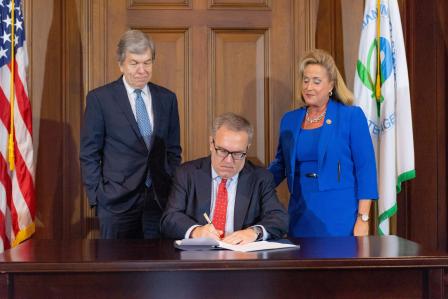 Acting Administrator Wheeler signs the Record of Decision Amendment for the West Lake Landfill Superfund site.On Sept. 27, 2018, Acting Administrator Andrew Wheeler signed the Record of Decision (ROD) Amendment for the West Lake Landfill Superfund site in Bridgeton, Missouri. This document amends the 2008 ROD and finalizes the Agency’s cleanup decision for Operable Unit 1. EPA expects the remedy to take approximately three years to complete after construction begins.
Acting Administrator Wheeler signs the Record of Decision Amendment for the West Lake Landfill Superfund site.On Sept. 27, 2018, Acting Administrator Andrew Wheeler signed the Record of Decision (ROD) Amendment for the West Lake Landfill Superfund site in Bridgeton, Missouri. This document amends the 2008 ROD and finalizes the Agency’s cleanup decision for Operable Unit 1. EPA expects the remedy to take approximately three years to complete after construction begins.
- Press Release
- Signing Event VideoExit
- Record of Decision Amendment
- Fact Sheet
- West Lake Site Profile Page
Principles for Reinforcing Federal Facility Agreement Informal and Formal Dispute Timelines
The pace of cleanup at federal facility Superfund sites can be delayed when Federal Facility Agreement (FFA) parties continue disputes beyond the agreed-upon dispute resolution timelines specified in negotiated FFAs. However, because disagreements and disputes are fact-specific, a fluid rather than a one-size-fits-all process may at times be necessary. This memorandum sets out principles clarifying and reinforcing the importance of adhering to agreed-upon FFA informal and formal dispute timelines. These principles support Recommendation 18 of the Administrator's Superfund Task Force Recommendations report, released on July 25, 2017.
- Memorandum (PDF)(4 pp, 3 MB)
Acting Administrator Wheeler Updates List of Superfund Sites Targeted for Immediate, Intense Action
On August 3, 2018, EPA released the next revision of the Administrator’s Emphasis List of Superfund Sites Targeted for Immediate, Intense Action. Eight sites (Centredale Manor Restoration Project, American Cyanamid Co., Ventron/Velsicol [aka Berry's Creek], Delaware Sand & Gravel Landfill, B.F. Goodrich, Mississippi Phosphates Corporation, Allied Paper, Inc./Portage Creek/Kalamazoo River, and Casmalia Resources) have been removed from the Administrator’s Emphasis List, as the specific goals, objectives, and milestones associated with these sites have been achieved due to the direct involvement of Acting Administrator Andrew Wheeler and former EPA Administrator Scott Pruitt.
Site Remediation Enforcement Director Issues Memorandum to the Regions to Support Long-Term Stewardship
In July 2018, EPA issued a new memorandum titled “Advance Monitoring Technologies and Approaches to Support Long-Term Stewardship.” The memorandum provides the Regions with information on the potential use of advance monitoring technologies and approaches for monitoring and maintaining institutional and engineering controls at sites and facilities addressed under federal and state cleanup authorities. The memorandum was issued as part of 2017 Task Force Report Recommendation 20 – Identify Opportunities to Engage Independent Third Parties to Oversee Certain Aspects of PRP-Lead Cleanups.
Acting Administrator Andrew Wheeler Commemorates the One-Year Anniversary of the Superfund Task Force at the New Bedford Harbor Superfund Site
 Acting Administrator Wheeler joins Mayor Jon Mitchell and Region 1 Administrator Alexandra Dunn on a boat tour of the New Bedford Harbor Superfund Site construction. Here they watch the dredging operation removing PCB contaminated sediment from the Harbor.On July 25, 2018, EPA’s Acting Administrator Andrew Wheeler traveled to Massachusetts to commemorate the one-year anniversary of the Superfund Task Force Report, assess ongoing cleanup efforts at the New Bedford Harbor Superfund Site, tour a solar power plant, and visit with EPA’s Region 1 office.
Acting Administrator Wheeler joins Mayor Jon Mitchell and Region 1 Administrator Alexandra Dunn on a boat tour of the New Bedford Harbor Superfund Site construction. Here they watch the dredging operation removing PCB contaminated sediment from the Harbor.On July 25, 2018, EPA’s Acting Administrator Andrew Wheeler traveled to Massachusetts to commemorate the one-year anniversary of the Superfund Task Force Report, assess ongoing cleanup efforts at the New Bedford Harbor Superfund Site, tour a solar power plant, and visit with EPA’s Region 1 office.
“On the one-year anniversary of the Superfund Task Force Report, EPA can proudly say that we have made tremendous progress moving sites toward deletion and expediting the cleanup and redevelopment of sites for the benefit of the surrounding communities,” said EPA Acting Administrator Andrew Wheeler. “The New Bedford Harbor Superfund Site is a great example of EPA working with state and local partners to accelerate cleanup and redevelopment simultaneously – a model for other sites around the nation.”
EPA Announces Dredging and Capping Pilot Study at the Gowanus Canal Superfund Site is Entering its Final Phase
On July 23, 2018 EPA announced that the Gowanus Canal Superfund Site’s dredging and capping pilot study is entering its final phase – the capping phase. A tour highlighted the successes of the study and the project overall, as an example of the overall success of the Superfund program and the renewed focus on Superfund as a critical part of EPA’s core mission. Under EPA oversight, approximately 17,000 cubic yards of contaminated sediment have been dredged from the Gowanus Canal’s 4th Street turning basin. The pilot project will inform the overall engineering design that will lead to the dredging and capping of the entire Gowanus Canal.
EPA Region 5 Administrator Announces Cleanup Achievements at the Kalamazoo River Superfund Site in Michigan
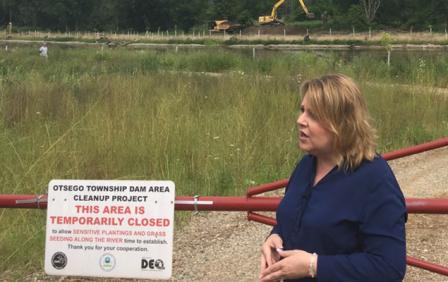 EPA Region 5 Administrator Cathy Stepp at the Kalamazoo River Superfund Site.
EPA Region 5 Administrator Cathy Stepp at the Kalamazoo River Superfund Site.
One year after U.S. Environmental Protection Agency’s Superfund Task Force identified the Kalamazoo River Superfund site in Otsego, Michigan, as a site of emphasis, EPA Region 5 Administrator Cathy Stepp joined state officials and community members to tour the site and view progress. Over the past year, EPA removed the Otsego Township Dam, restored native plants and grasses, and stabilized the eroded riverbank soils near the M-89 bridge. This summer, EPA will finish building a parking lot which will provide residents with easy access to the river.
Superfund Director Issues Memorandum to the Regions to Broaden the Use of Adaptive Management at Sites
EPA issued a new memorandum titled “Superfund Task Force Recommendation #3: Broaden the Use of Adaptive Management.” The memorandum provides a working definition of adaptive management (AM) for use in the Superfund remedial program and outlines an implementation plan to expand the use of AM at sites.
- Superfund Task Force Recommendation #3: Broaden the Use of Adaptive Management (PDF)(6 pp, 1.3 MB, About PDF)
Memorandum to the Regions regarding Recommendation 12 of the Superfund Task Force Report
EPA has developed a new guidance memorandum titled “Bifurcating Remedial Design and Remedial Action to Accelerate Remedial Design Starts at PRP-Lead Superfund Sites.” The guidance recommends that Regions consider using separate settlement tracks for remedial design and remedial action where negotiations for a single consent decree addressing both remedial design/remedial action are likely to be protracted.
Treatment Begins at CTS of Asheville Superfund Site
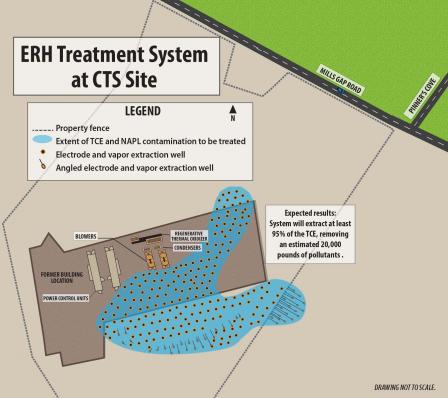 Map showing electrical resistance heating treatment system components at the CTS Site.
Map showing electrical resistance heating treatment system components at the CTS Site.
Treatment is underway to clean up contaminants in the groundwater and soil at the CTS of Asheville, Inc. Superfund Site (Site) in Asheville, NC. Historical use of solvents in the manufacturing of electronic components contaminated the CTS Site with trichloroethene (TCE). Electrical Resistance Heating (ERH) is being used to treat a 1.2-acre area beneath the former CTS plant. System startup and testing began on May 29, 2018, and reached full operating power on June 8. The system will operate through the fall of 2018 and is designed to extract 95 percent of the TCE in the treatment area, removing an estimated 20,000 pounds of pollutants.
EPA Announces Cleanup Proposal for American Cyanamid Superfund Site in Bridgewater Township, NJ
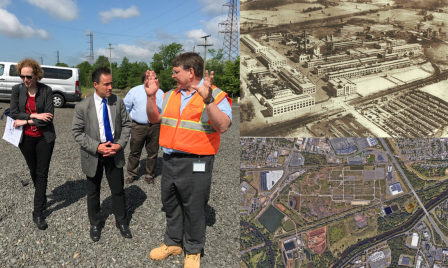 (Left) Region 2 Administrator, Pete Lopez, tours the American Cyanamid Superfund site with NJDEP Deputy Commissioner, Debbie Mans, and Pfizer officials to announce $74 million cleanup plan for the site. (Top right) Rendered image of the American Cyanamid Company, circa 1960. (Bottom right) 2018 aerial view of the site.On May 24, EPA Region 2 Administrator Pete Lopez was joined by New Jersey Department of Environmental Protection (NJDEP) Deputy Commissioner Debbie Mans and Bridgewater Township Director of Human Services Kristen Schiro to announce the cleanup proposal for the final portion of the American Cyanamid Superfund site in Bridgewater Township, NJ. This Superfund site is on both the National Priorities List (NPL) and former Administrator Pruitt’s list of Superfund sites targeted for immediate and intense attention released in December 2017.
(Left) Region 2 Administrator, Pete Lopez, tours the American Cyanamid Superfund site with NJDEP Deputy Commissioner, Debbie Mans, and Pfizer officials to announce $74 million cleanup plan for the site. (Top right) Rendered image of the American Cyanamid Company, circa 1960. (Bottom right) 2018 aerial view of the site.On May 24, EPA Region 2 Administrator Pete Lopez was joined by New Jersey Department of Environmental Protection (NJDEP) Deputy Commissioner Debbie Mans and Bridgewater Township Director of Human Services Kristen Schiro to announce the cleanup proposal for the final portion of the American Cyanamid Superfund site in Bridgewater Township, NJ. This Superfund site is on both the National Priorities List (NPL) and former Administrator Pruitt’s list of Superfund sites targeted for immediate and intense attention released in December 2017.
EPA will hold a public meeting on June 12, 2018 to explain the cleanup proposal and other options considered and to take public comments. An informal public information session will be held at 6:00 p.m. and the public meeting will begin at 7:00pm at Bridgewater Township Municipal Building.
EPA Region 1 Administrator Alexandra Dunn and Connecticut Environmental Commissioner Robert Klee celebrate that the cleanup of the Raymark Industries Superfund Site in Stratford, Conn. will begin soon
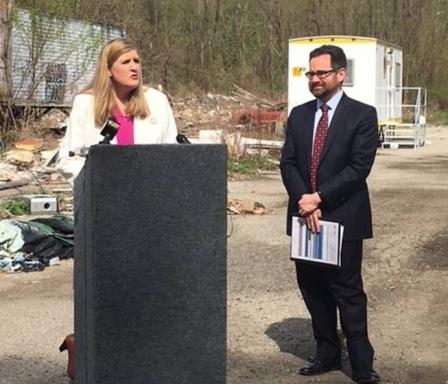 EPA Region 1 Administrator Alexandra Dunn and Connecticut Environmental Commissioner Robert Klee celebrate that the cleanup of the Raymark Industries Superfund Site in Stratford, Conn. will begin soon.
EPA Region 1 Administrator Alexandra Dunn and Connecticut Environmental Commissioner Robert Klee celebrate that the cleanup of the Raymark Industries Superfund Site in Stratford, Conn. will begin soon.
On May 7, EPA Region 1 Administrator Alexandra Dunn visited the Raymark Industries Superfund Site in Stratford, Conn. The site is on the Superfund Task Force’s Redevelopment List, and progress is being made with the help of and strong partnership with the State of Connecticut, the Town of Stratford and the Stratford community. We have prioritized funding for this site, and will be executing the Raymark cleanup this construction season to make a real environmental and economic difference for the people of Stratford.
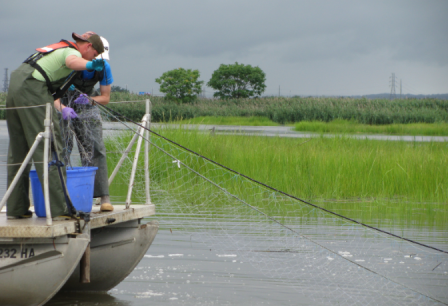 EPA Proposes Interim Plan to Address Contamination for Berry's Creek Portion of Ventron/Velsicol Superfund Site in NJ
EPA Proposes Interim Plan to Address Contamination for Berry's Creek Portion of Ventron/Velsicol Superfund Site in NJ
On April 30, 2018, EPA took an important step towards addressing serious contamination in the Berry’s Creek Study Area, which is part of the Ventron/Velsicol Superfund site in Bergen County, N.J., by proposing a plan to take actions to address known sources of the contamination. The Berry’s Creek portion of the Superfund site is on former EPA Administrator Scott Pruitt’s Emphasis List of Superfund sites.
The EPA will hold a public meeting on May 9th in Little Ferry, NJ to explain the cleanup proposal and other options considered and to take public comments.
EPA issues guidance on disbursement of special account funds to entities performing cleanup work at Superfund sites
On March 27, 2018, EPA’s Special Accounts Senior Management Committee (SASMC) issued a memorandum intended to maximize the use of special accounts to facilitate site cleanup and/or redevelopment under Recommendation 14 of the Superfund Task Force report. The memo, issued to the Regional offices, provides guidance on disbursing special account funds, under the authority of the Comprehensive Environmental Response, Compensation, and Liability Act (CERCLA, commonly referred to as Superfund), to entities (federal, state, and tribal agencies, community groups, bona fide prospective purchasers, and potentially responsible parties, if eligible) who will be performing cleanup work (response activity) at Superfund sites.
- Guidance on Disbursement of Funds from Special Accounts to Entities Performing CERCLA Response Actions (PDF)(14 pp, 883 K), March 27, 2018.
EPA Releases Two Technical Documents to Further Use of In Situ Remediation Technologies
These documents support Recommendation 9 related to technologies to expedite site cleanup. The target audience includes cleanup professionals, such as federal and state remedial project managers.
In Situ Treatment Performance Monitoring: Issues and Best Practices discusses issues that are likely to occur in monitoring wells during and after active in situ treatment at contaminated sites. The paper discusses potential sampling or analytical issues associated with in situ treatment technologies; highlights the mechanisms and resulting impacts on performance monitoring; and provide best practices to identify and mitigate issues that may affect sampling or analysis.
Remedial Technology Fact Sheet– Activated-Carbon Based Technology for In Situ Remediation describes a recently-developed remedial technology that applies a combination of activated carbon and chemical or biological amendments for in situ remediation of soil and groundwater contaminated by organic contaminants, primarily petroleum hydrocarbons and chlorinated solvents. This technology has been applied with increasing frequency at contaminated sites across the country, including four Superfund sites. The fact sheet summarizes the science, engineering, and performance data associated with in situ carbon-based amendments.
Former Administrator Pruitt Signs $107.6M Action Memorandum to Clean Up the Mississippi Phosphates Corporation Superfund Site
 In-Site Wastewater Treatment – EPA is overseeing wastewater treatment at a rate of approximately 2-4 million gallons per day—at a cost of over $1 million per month. The wastewater is treated with lime to neutralize pH and remove nutrients (milky cells, lower left).
In-Site Wastewater Treatment – EPA is overseeing wastewater treatment at a rate of approximately 2-4 million gallons per day—at a cost of over $1 million per month. The wastewater is treated with lime to neutralize pH and remove nutrients (milky cells, lower left).
On April 18, 2018, the former EPA Administrator Scott Pruitt signed an Action Memorandum for $107.6 million accelerating the cleanup of the former Mississippi Phosphates Corporation (MPC) Site in Pascagoula, Miss. In just over a year of taking action on the site to manage emergency wastewater treatment operations, former Administrator Pruitt and the Agency signed an Action Memorandum to begin cleanup in July 2018.
EPA formally added the MPC Site to the Superfund National Priorities List and proposed a cleanup plan for portions of the MPC Site in January 2018. The Action Memorandum signed today selects a $71.6 million cleanup that will take place from 2018 through 2020, plus $36 million for ongoing wastewater treatment during the three-year cleanup period.
Memorandum Issued to Spur Investment and Address Liability Concerns for Third Parties at Superfund Sites
As reflected in the Superfund Task Force Report, EPA and the Department of Justice (DOJ) are committed to addressing liability concerns to encourage third party investment in cleanup of contaminated sites. EPA and DOJ recognize that a site-specific agreement with the federal government may be necessary at certain sites to address the liability concerns before the site cleanup and reuse can happen. To encourage more clean up and reuse by Bona Fide Prospective Purchasers (BFPPs), prospective purchasers, and other third parties, on April 17, 2018, EPA and DOJ issued a new policy memo encouraging staff to consider more frequent use of agreements with these parties at appropriate sites on the Superfund National Priorities List (NPL).
Former Administrator Pruitt Updates List of Superfund Sites Targeted for Immediate, Intense Action
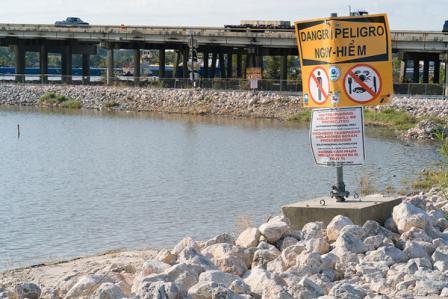 San Jacinto River Waste Pits, now removed from Emphasis List
San Jacinto River Waste Pits, now removed from Emphasis List
On April 16, 2018, EPA removed two Superfund sites from the Emphasis List and added three as cleanup continues across the country.
The updated Emphasis List no longer includes the Anaconda Copper Mine in Nevada and San Jacinto River Waste Pits in Texas as cleanup activities progress and completion of specific milestones and timelines at these sites have benefited from the former Administrator’s influence. The Casmalia Resources site in California, Delaware Sand & Gravel Landfill site in Delaware, and St. Regis Paper Company site in Minnesota were also added to the list to spur action on cleanup and redevelopment efforts.
- Press Release
- Casmalia Resources Superfund Site
- Delaware Sand & Gravel Landfill Superfund Site
- St. Regis Paper Company Superfund Site
EPA Reaches Agreement on San Jacinto River Cleanup
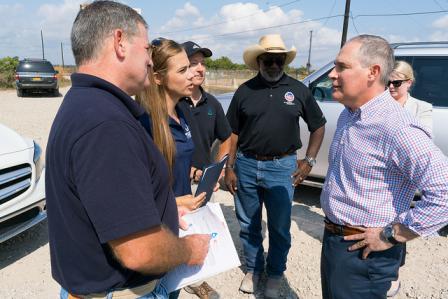 Administrator Pruitt tours the San Jacinto River Superfund Site with Scott Jones of the Galveston Bay Foundation and Jackie Young of the Texas Health and Environment Coalition.
Administrator Pruitt tours the San Jacinto River Superfund Site with Scott Jones of the Galveston Bay Foundation and Jackie Young of the Texas Health and Environment Coalition.
An agreement has been reached with International Paper Company and McGinnes Industrial Maintenance Corporation to perform a remedial design to address dioxin contamination at the San Jacinto River Waste Pits Superfund Site.
The design includes installing engineering controls before excavating approximately 212,000 cubic yards of dioxin contaminated material for disposal.
Superfund Task Force Issues Second Quarterly Report
The quarterly report provides a comprehensive list of accomplishments from January to March 2018. The Task Force will be providing these updates on a quarterly basis.
- Task Force Quarterly Report: Second Quarter FY 2018 (PDF)(33 pp, 1.7 MB)
EPA Deletes Part of Pacific Coast Pipe Line Site from National Priorities List
A portion of the Pacific Coast Pipeline site is now ready for commercial and recreation use. On March 23, 2018, EPA deleted that portion of the site from the National Priorities List (NPL) after sampling showed that all contaminants of concern in the site soil are below levels required by the site’s Record of Decision for commercial and recreational use.
Deleting a site or portions of a site from the NPL may facilitate future redevelopment, one of EPA’s goals for the Superfund program.
Accelerating NPL sites to completion is one focus area of the Superfund Task Force Recommendations that were announced in July 2017 to improve and revitalize the Superfund program.
EPA Deleted Massachusetts Site from National Priorities List
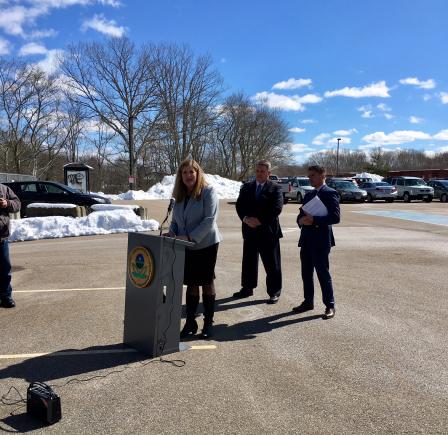 On Mar. 15, EPA announced the deletion of the Hatheway & Patterson Superfund site in Mansfield and Foxborough, Massachusetts, from the National Priorities List (NPL).
On Mar. 15, EPA announced the deletion of the Hatheway & Patterson Superfund site in Mansfield and Foxborough, Massachusetts, from the National Priorities List (NPL).
"Under Administrator Pruitt's leadership, EPA is laser focused on making progress at Superfund sites," said EPA Region 1 Administrator Alexandra Dunn (pictured at right). "Deleting Hatheway & Patterson from the NPL is an exciting moment, marking the completion of many years of cleanup work and returning the site to the towns for future planning."
Deleting the site means that EPA and the Commonwealth of Massachusetts Department of Environmental Protection (MassDEP) have concluded that all appropriate Superfund-financed response actions under the Comprehensive Environmental Response, Compensation and Liability Act (CERCLA), have been implemented and that no further cleanup is appropriate for the site. Moreover, EPA and MassDEP have determined that cleanup actions conducted at the site to date continue to be protective of public health and the environment.
EPA Holds Public Meeting to Discuss West Lake Landfill Proposed Plan
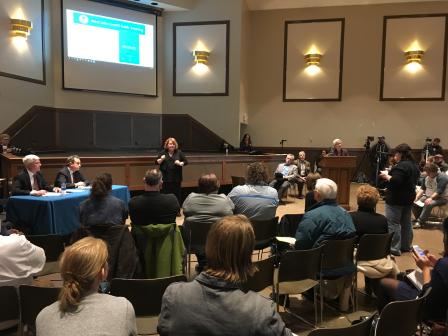 Seated at the head table, Albert (Kell) Kelly, EPA’s Superfund Task Force Chair and senior advisor to Administrator Scott Pruitt, and EPA Region 7 Regional Administrator Jim Gulliford chair the public comment meeting for the West Lake Landfill proposed plan.
Seated at the head table, Albert (Kell) Kelly, EPA’s Superfund Task Force Chair and senior advisor to Administrator Scott Pruitt, and EPA Region 7 Regional Administrator Jim Gulliford chair the public comment meeting for the West Lake Landfill proposed plan.
On Mar. 6, 2018, EPA held a public meeting in Bridgeton, Missouri, to discuss the proposed plan for cleanup of the nearby West Lake Landfill site. More than 600 community members and officials attended the meeting.
EPA has published the proposed plan and approved a request to extend the public comment period, which will now run through Apr. 23, 2018.
EPA Deletes Two Washington State Superfund Sites from NPL
EPA has officially deleted the Vancouver Water Stations #1 and #4 Superfund sites from the National Priorities List (NPL).
“The City of Vancouver stepped up, addressed the contamination at these two sites and made these deletions possible,” said former EPA Administrator Scott Pruitt. “This is cooperative federalism at work. They are clearly our partner in the effort to clean up sites, shrink the National Priorities List and make more land available for redevelopment.”
EPA and the State of Washington have concluded that all appropriate responses under the Comprehensive Environmental Response, Compensation and Liability Act have been implemented and that no further cleanup is required. Sites can only be proposed for deletion once all remedies are successfully implemented and EPA and the State have determined that cleanup actions conducted at the sites to protect both public health and the environment have been completed.
EPA Announces Proposed Remedy for West Lake Landfill
On Feb. 1, former EPA Administrator Scott Pruitt announced the proposed remedy to clean up the West Lake Landfill site in Bridgeton, Missouri. West Lake is one of the Administrator’s 21 sites targeted for intense, immediate action.
“The people of the St. Louis region deserve clarity and answers with respect to the remediation of the West Lake Landfill,” said former Administrator Pruitt. “I promised them an answer, and today I am making good on that commitment.”
The proposed remedy – “Excavation Plus” – includes both the removal of the majority of the radioactive material and construction of an engineered cover system to best protect the community of Bridgeton over the long term. This remedy addresses all radioactive material posing unacceptable future risks to the public at large.
The Proposed Plan and Administrative Record will be issued in the following days and available for public review and comment.
2017
Superfund Task Force Issues First Quarterly Report
The quarterly report provides a comprehensive list of accomplishments from October to December 2017. The Task Force will be providing these updates on a quarterly basis.
EPA Releases List of Superfund Sites Targeted for Immediate, Intense Attention
These are sites requiring timely resolution of specific issues to expedite cleanup and redevelopment efforts. The list is designed to spur action at sites where opportunities exist to act quickly and comprehensively.
EPA Releases Superfund Redevelopment Focus List
Superfund sites on this list are those with the greatest expected redevelopment and commercial potential. Superfund redevelopment has helped countless communities reclaim and reuse thousands of acres of formerly contaminated land.
Superfund Completes Deletion Activities at Seven National Priorities List Sites in 2017
As a result of staff working hard to implement former Administrator Scott Pruitt’s initiatives to make strides in cleaning up the nation’s most contaminated toxic land sites, the U.S. Environmental Protection Agency (EPA) announced significant improvement in 2017 – through the deletion of all or parts of seven Superfund sites from the National Priorities List (NPL). This is more than triple the number of sites removed from the list in 2016.
Task Force Ramps Up Redevelopment Efforts
Between October and December 2017, EPA conducted numerous site-specific redevelopment activities, including:
- Fielded 17 redevelopment-related prospective purchaser inquiries, including requests related to sites on the Redevelopment Focus List.
- Provided support to 15 new and ongoing Superfund Redevelopment Initiative regional seed projects.
- Developed fact sheets on each Redevelopment Focus List site as well as 27 sites in EPA Region 4 (Southeast U.S.) to provide site owners, future site users, prospective purchasers, lenders and developers with valuable site-specific information.
- Posted new map on EPA’s Superfund Redevelopment Initiative website to easily locate and find information on all Superfund sites in reuse.
- Published information regarding sites that achieved the Sitewide Ready for Anticipated Use performance measure in FY 2017.
EPA Releases Superfund Human Exposure Dashboard
This dashboard provides the status of EPA’s site-wide Human Exposure environmental indicator for each Superfund National Priorities List and Superfund Alternative Approach site. Human Exposure is one of the metrics EPA uses to communicate its progress in cleaning up Superfund sites. EPA has been providing this information on each of these Superfund sites’ webpages. The Task Force developed this dashboard to provide human exposure status in a single location.


